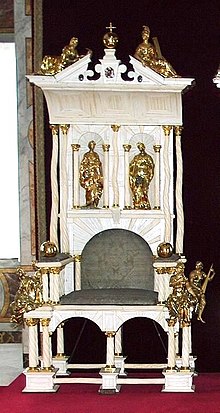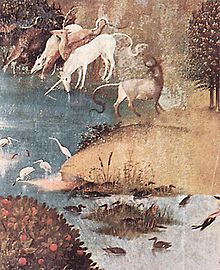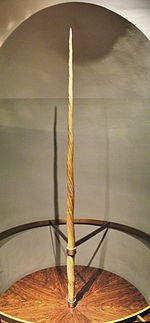Unicorn horn

A unicorn horn, also known as an alicorn,[1] is a legendary object whose reality may have been accepted in Western Europe throughout the Middle Ages. Many healing powers and antidote's virtues were attributed to the horn of the unicorn. These properties, assumed real since the 13th century, made it one of the most expensive and most reputable remedies during the Renaissance,[2] and justified its use in royal courts. Beliefs related to the "unicorn horn" influenced alchemy through spagyric medicine. The horn's purification properties were eventually put to the test in, for example, the book of Ambroise Paré, Discourse on unicorn - marking the beginnings of the experimental method.
Seen as one of the most valuable assets that a king could possess, unicorn horns were exchanged and could be purchased at apothecaries as universal antidotes until the 18th century. Other horns were displayed in cabinets of curiosities. The horn was used to create sceptres and other royal objects, such as the "unicorn throne" of the Danish kings, the sceptre and imperial crown of the Austrian Empire, and the scabbard and the hilt of the sword of Charles the Bold. The legendary unicorn was never captured, but its symbolic association with virginity made it the symbol of the incarnation of God's Word, innocence and divine power
Belief in the power of the unicorn's horn and its origins persisted from the Middle Ages to the 18th century, when the true source, the narwhal, was discovered. This marine mammal is the true bearer of the "unicorn horn", actually an extended tooth found in the mouth of males and some females. Since then, the unicorn horn has been mentioned in fantasy works, role-playing games and video games, which make use of its legendary symbolism.
Nature and properties

Coming from an ancient figure, the unicorn was described by Ctesias as carrying a horn which Indian princes would use to make hanaps against poison. These writings were taken up by Aristotle and Pliny the Elder;[3] Claudius Aelianus also said that drinking in this horn protects against diseases and poisons.[4] These writings influenced the authors from the Middle Ages to the Renaissance: the unicorn becomes the most important and most frequently mentioned imaginary animal in the West, its existence was considered real. Other parts of its body were given medicinal properties and, in the 12th century, abbess Hildegard of Bingen recommended an ointment against leprosy made from foie de licorne and egg yolk.[5] Wearing a unicorn leather belt was supposed to protect a person from the plague and fever, while leather shoes of this animal lure diseases away from feet.[6]
The actual medicinal use was linked to its horn and purification power assumed true since Antiquity, which was explicitly mentioned for the first time in the 13th century. Legends about these properties circulating since the Middle Ages were the origin of a flourishing trade of these objects, which became more common up to the late 18th century, when their true origin was unknown. The unicorn never existed as represented; it is most often narwhal teeth known as "unicorn horns" during these times.[7]
Water purification

The first reference to the cleansing power of the unicorn appears in an interpretation of the Physiologus (dated 14th century), when reference is made to a large lake where animals congregate to drink:
But before they are gathered, the snake comes and throws his poison in the water. So many animals notice the poison and dare not to drink, and they expect the unicorn. It comes and it goes immediately to the lake, with its horn making the sign of the cross, it makes the poison harmless. All other animals drink then.[8]
The theme soon became popular, the stage of purification of water by a unicorn is taken in 1389 by the father Johann van Hesse, who claims to have seen a unicorn emerge from the sea to clean impure water so that animals could drink[9] Symbolically, the snake that poisons the water is the devil and the unicorn represent Christ the Redeemer.[10] The origin of this legend seems Indian, through the Greek texts mention the fact that the Indian nobles might drink out of unicorn horns to protect themselves from diseases and poisons.[9]
The unicorn is most often represented by a river, a lake or a fountain, while animals wait for her to finish her work to drink. This scene is very common in the art of the 16th and 17th centuries.[11] Studies and translations of these drawings and stories popularized the belief that the power of the animal comes from its horn, which would eliminate the poisons as it hits a liquid.[9] Water purification forge the legend on the properties of the "unicorn horn" and later justifies its use as a universal antidote.
Medicinal properties

The alleged properties of the unicorn horn can be paralleled to those of the bezoar stone, another object of animal origin known in the Renaissance medicine and exposed as a rarity in the cabinets of curiosities.[12]
The unicorn horn was very quickly assigned many medicinal properties and, over time, in addition to the purification of polluted water in nature,[13] its use was recommended against rubella, measles, fevers and pains.[14] The monks of the Parisians monasteries used to soak it in the drinking water given to lepers.[13] It acted as an antidote and, in a powder form, was known to facilitate wound healing, help neutralize poisons (such as scorpion or viper venom)[15] or against the plague.[16] It would also have an aphrodisiac power known since ancient times[17] and would test the virginity of young girls.[18] The horn was consumed in several ways, in substance or infusion[19]
Its prophylactic function and magical power, although known for centuries, while its trade increases, several «fake» horns and false powders appeared.[20] The astronomical value achieved by these objects left to assume that their imaginary virtues could cause real healing,[13] probably due to the placebo effect.
This use of the unicorn horn in medicine is because therapists then had very few instruments and objects, and the ancient heritage meant that they were only instruments of God. The Inquisition played a role in this belief: to doubt the powers of the horn meant doubting the existence of the unicorn itself, animal of God mentioned in a translation of the Bible. Skeptics risked to be burned at the stake.[21]
Many works are devoted to the explanation and defense of the medicinal properties of the «unicorn horn», including The Treaty of the Unicorn, its wonderful properties and its use (1573) by Andrea Bacci and Natural History, Hunting, Virtues, and Use of Lycorn (1624) by apothecary Laurent Catelan. Bacci probably wrote his book at the request of his patients, who were major investors in the unicorn horn trade.[22]
Display and use as antipoison

Twisted shape "unicorn horns" were exchanged and in circulation for a long time: according to a legend, the "horn" on display at the Musée national du Moyen Âge was a gift from the Caliph of Baghdad, Harun al-Rashid, to Charlemagne in 807.[4] It measures almost three meters.[23] An eight-foot long horn is exhibited in Bruges, Flanders.[4] Since the Middle Ages, the "unicorn horn" is supposed to be the most valuable asset that a king could possess.[15] Its medicinal use is attested since the 13th century, when pharmacists incorporated narwhal teeth (presented as unicorn horns) in their treatments and they had large pieces so it could not be confused with that of another animal, such as ox.[24] These objects would have been exchanged up to eleven times their weight in gold.[13] Some horns, introduced reportedly during the Fourth Crusade of Constantinople, were thrown into the pit of the Doge's Palace in Venice, so that water could never be poisoned. Horns considered sacred relics can be found at the Council of Trent in 1563, as well as the Saint-Denis Cathedral in Paris, St Mark's Basilica in Venice and Westminster Abbey in London. They were usually mounted on silver socles and presented as trophies that could only be shown for important ceremonies.[15]
Ambroise Paré explains that the horns were used in the court of the King of France to detect the presence of poison in food and drink: if the horn became hot and started to smoke, then the dish was poisoned.[25] Pope Clement VII would have offered a unicorn horn of two cubits long to King Francis I of France at the wedding of his niece Catherine de' Medici in Marseille in October 1533,[26] and the king did not ever move without a bag filled with unicorn powder.[3] Also, the Grand Inquisitor Torquemada always bore his unicorn horn to protect himself from poison and murderers.[27]
References
- ^ Shepard, Odell (1930). The Lore of the Unicorn. London: Unwin and Allen. ISBN 9781437508536.
- ^ Faidutti 1996, p. 13
- ^ a b Davenne 2004, p. 130
- ^ a b c de Tervarent 1997, pp. 281–287
- ^ de Bingen 1989, pp. 196–197
- ^ Lecouteux 1993, p. 45
- ^ Didrit, Mireille; Pujol, Raymond (September 1996). "Note de recherche d'Ethnozoologie : Licorne de Mer ou Licorne de Terre : le Narval" (in French). Paris: Université Paris V - Sorbonne. Retrieved 21 September 2012.
- ^ Der Physiologus cited in Freeman 1983, p. 27
- ^ a b c Faidutti 1996, p. 39
- ^ Faidutti 1996, p. 59
- ^ Faidutti 1996, p. 61
- ^ Martin, Jean Hubert; Jean Guillaume and Frédéric Didier (2000). Le château d'Oiron et son cabinet de curiosités. Éditions du patrimoine, p. 131
- ^ a b c d Rochelandet 2003, p. 131
- ^ Valentini 1704, p. vol. 3, ch. 30
- ^ a b c Brasey 2007, pp. 259–263
- ^ Paré, Ambroise (1628). Les œuvres d'Ambroise Paré (in French). N. Buon. p. 812. Retrieved September 28, 2012.
- ^ Ferlampin-Acher 2002, p. 297
- ^ Graitson, Jean-Marie (1997). Actes du colloque Frankenstein littérature/cinéma. Chaudfontaine. p. 68. ISBN 9782871300540. Retrieved September 28, 2012.
{{cite book}}: CS1 maint: location missing publisher (link) - ^ Pomet 1696, p. 26
- ^ Rochelandet 2003, p. 130
- ^ Lemoine 1996, p. 147
- ^ Giblin 1991, p. 77
- ^ Mireille Didrit; Raymond Pujol (1996). Licorne de Mer ou Licorne de Terre : le Narval (Master). Université Paris-V - Sorbonne.
- ^ Buck & Centre d'études supérieures de la Renaissance 1973, p. 215
- ^ Malrieu 1987, p. 131
- ^ Fagnart, Laure (2009). Léonard de Vinci en France: collections et collectionneurs : XVe-XVIIe siècles (in French). L'Erma di Bretschneider. p. 161. ISBN 9788882655549.
- ^ Lutavd 1906, pp. 197–199
Bibliography
Founding works on medicine and alchemy
- de Bingen, Hildegarde (1989). Le Livre des subtilités des créatures divines (in French). Vol. II. Paris: Millon. ISBN 2905614315.
- Marini, Andrea (1566). Discorso contro la falsa opinione dell'Alicorno (in Italian). Venice.
- Bacci, Andrea (1573). L'alicorno discorso dell'eccellente medico et filosofo M. Andrea Bacci: nel quale si tratta della natura dell' alicorno et delle sue virtu eccellentissime (in Italian). G. Marescotti. p. 80.
- Paré, Ambroise (1582). Discours d'Ambroise Paré : À savoir, de la mumie, de la licorne, des venins et de la peste (in French). Paris. Retrieved September 20, 2012.
- Paré, Ambroise (1928). Voyages et apologie suivis du Discours de la licorne (in French).
{{cite book}}:|access-date=requires|url=(help) - Pomis, David (1587). Dittionario novo hebraïco (in Italian). Venice.
{{cite book}}:|access-date=requires|url=(help) - Linocier, Geoffroy (1584). Histoire des plantes avec leurs pourtraictz, à laquelle sont adjoutées celles des simples, aromatiques, animaux à quatre pieds, oiseaux, serpens et autres bêtes venimeuses (in French). Paris. Retrieved September 20, 2012.
- Valentine, Basil (1678). Triumphal Chariot of Antimony. Retrieved September 20, 2012.
- Rodrigo a Castro, Esteban (1621). De Meteoris Microcosmi (in Italian). Florence.
{{cite book}}:|access-date=requires|url=(help) - Catelan, Laurent (1624). Histoire de la nature, chasse, vertus, proprietez et usage de la lycorne (in French).
{{cite book}}:|access-date=requires|url=(help) - Pomet, Pierre (1696). Histoire générale des drogues, traitant des plantes, des minéraux et des animaux (in French). Vol. II. Paris. Retrieved September 20, 2012.
Founding travel and exploration stories
- Belon, Pierre (1553). Les Observations de plusieurs singularités et choses mémorables trouvées en Grèce, Asie, Judée, Égypte, Arabie et autres pays estranges, rédigées en trois livres (in French). Paris: G. Corrozet.
{{cite book}}:|access-date=requires|url=(help) - Goropius, Johannes (1569). Origines Antwerpianæ (in Dutch). Antwerp.
{{cite book}}:|access-date=requires|url=(help) - Mercator, Gérard (1607). Atlas Minor: traduction française par M. de la Popelinière (in French). Amsterdam.
{{cite book}}:|access-date=requires|url=(help) - Bartholin, Thomas (1645). De Unicornu Observationes Novæ (in Latin). Padoue. Retrieved September 20, 2012.
- Collinson, Sir Richard (1867). The Three Voyages of Martin Frobisher in Search of a Passage to Cathaia and India by the North-West, 1576-8, A.D. 1576-8. London: Hakluyt Society. p. 374. Retrieved September 20, 2012.
Founding works on zoology
- Gesner, Conrad (1603). Historiæ Animalium de Quadrupedibus Viviparis (in Latin). Frankfurt. Retrieved September 20, 2012.
- Aldrovandi, Ulysse (1616). De Quadrupedibus Solipedibus (in Italian). Bologna. Retrieved September 20, 2012.
- Valentini, Michael Bernhard (1704). "30". Museum Museorum (in Latin). Vol. III. Frankfurt.
{{cite book}}:|access-date=requires|url=(help) - von Linné, Carl (1793). Systema Naturae (in Latin). Brussels.
{{cite book}}:|access-date=requires|url=(help)
Theses and studies
- Faidutti, Bruno (1996). Images et connaissance de la licorne: (Fin du Moyen Âge - xixe siècle) (Ph.D.) (in French). Vol. 1. Université Paris-XII. Retrieved 10 June 2009.
- Freeman, Margaret (1983). La chasse à la licorne: prestigieuse tenture française des Cloisters (in French). Lausanne: Edita. p. 247. ISBN 9782880010508.
- Lecouteux, Claude (1993). Les monstres dans la pensée médiévale européenne: essai de présentation (in French). Paris: Presses de l'Université de Paris-Sorbonne. p. 183. ISBN 9782840500216.
- de Tervarent, Guy (1997). Attributs et symboles dans l'art profane: dictionnaire d'un langage perdu (1450-1600) (in French). Librairie Droz. p. 535. ISBN 9782600005074. Retrieved September 20, 2012.
- Davenne, Christine (2004). Modernité du cabinet de curiosités (in French). L'Harmattan. p. 299. ISBN 9782747558600. Retrieved September 20, 2012.
External links
 The dictionary definition of alicorn at Wiktionary
The dictionary definition of alicorn at Wiktionary
